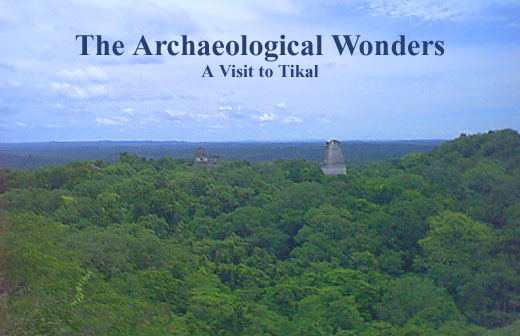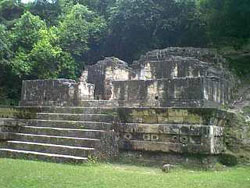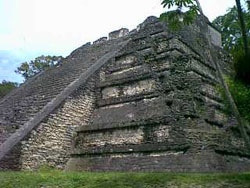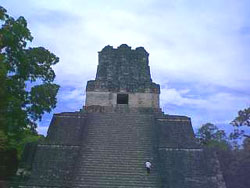
|
| Tikal
is located in Guatemala, not far from the Belizean border in the
Cayo District. The archaeological site sits in the middle of a Tikal
National Park, a wildlife preserve covering 222 square miles and
the first such park in Central America. The park shelters magnificent
jungle and wildlife. Some of the rainforest trees that grow in the
park are Spanish cedar, ceiba, a tree sacred to the Maya, zapotes,
from which chicle, a base for chewing gum is derived, and mahogany.
Living in and amongst these trees are troops of spider monkeys,
285 species of birds, 209 of which are resident species: including
hawks, hummingbirds, parrots, and golden turkeys. Outside of the
ruins live jaguar, puma, ocelot, pecarry, small deer, and many other animals, many rare and endangered. Tikal was a prime city of the Maya. At least 10,000 people lived
within the mapped portion of the city, which encompasses six square
miles. The maps reveal 3000 separate constructions, including
temples, palaces, shrines, cremonial platforms, residences, ballcourts,
terraces, causeways, and plazas. In the main ceremonial precincts
there are 200 stone monuments, known as stelae. Stelae were elaborately
carved with glyphs, a form of writing, and other images. The employment
of stelae was not general in Mayan culture, and seems to have
been confined to the southern portion of their lands, principally
around Tikal. |
 |
 |
|
 |
 |
|
| As well as the buildings and monuments, 100,000 tools, ceremonial objects, personal ornaments, and other items have been unearthed. These smaller object give a more intimate picture of the texture of ancient Mayan life. The humbler residences found at Tikal have told us a lot about the ordinary Maya. The houses at Tikal were typically arranged in clusters around a central plaza. Most people were buried beneath the houses they had lived in. Along with the bodies were ritual objects that seemed to have daily life uses as well. The ceramics that have been unearthed at Tikal are especially fine. The heart of Tikal is the Great Plaza. The plaza is surrounded the two largest temples, and to the north is a cluster of temples known as the North Acropolis. The Temple of the Giant Jaguar is especially notable. It was named after a motif on one of its lintels. Built in AD 870, it towers 145 feet above the Great Plaza. Tombs are riddled beneath and inside the structure. There are a couple of temple complexes at Tikal that are resonate as a group, even if the individual buildings are not especially spectacular. These complexes have been given such evocative names as the Lost World Complex, the Plaza of the Seven Temples, the Twin Pyramid Complex, and the Acropolis. Tikal is reachable by plane from Belize City or by overland traffic (bus, coach) from San Ignacio or any location in the Cayo district.. Flores is the closest town in Guatemala. You can find lodgings within the National Park. You can also charter a plane for a one-day visit from Belize. |
||
Photos
courtesy of TalkaboutTheWorld.com |
||

